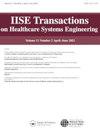使用NASA-TLX和SURG-TLX在高保真模拟器中开发腹腔镜手术工作量的主观仪器
IF 1.5
Q3 HEALTH CARE SCIENCES & SERVICES
IISE Transactions on Healthcare Systems Engineering
Pub Date : 2020-11-23
DOI:10.1080/24725579.2020.1854395
引用次数: 3
摘要
摘要外科手术任务负荷指数(SURG-TLX)和美国国家航空航天局任务负荷指数(NASA-TLX)是主观负荷评估工具。这些工具有三个一致的工作负载维度,但每个都有三个独特的维度。每个维度都由一个唯一的描述符解释。假设在评估相同的手术方法和任务时,SURG-TLX和NASA-TLX的工作量评分会有所不同。因此,本研究的目的是评估SURG-和NASA-TLX维度,以创建一种新的工作量仪器,以更好地预测模拟腹腔镜手术工作量。二十五(25)名参与者在中西部的一家大型教学医院被选中,使用四种不同的腹腔镜方法进行两项模拟手术任务。每位参与者总共完成了8次试验,每次试验后使用NASA-TLX和SURG-TLX评估工作量。与SURG-TLX总体维度相比,NASA-TLX总体维度的评分明显更高(更大的工作量)(F = 12.04, p = 0.001)。工作负荷维度的主成分分析表明,新的外科主观工作负荷测量工具应包括心理需求、生理需求、时间需求、表现、挫折和情境压力等维度。然而,需要对这种新工具进行验证。本文章由计算机程序翻译,如有差异,请以英文原文为准。
Developing a subjective instrument for laparoscopic surgical workload in a high fidelity simulator using the NASA-TLX and SURG-TLX
Abstract The Surgery Task Load Index (SURG-TLX) and National Aeronautics and Space Administration Task Load Index (NASA-TLX) are subjective workload assessment instruments. These instruments have three coinciding workload dimensions, but each has three unique dimensions. Each dimension is explained by a unique descriptor. It was hypothesized that the SURG-TLX and NASA-TLX workload ratings would differ when assessing the same surgical methods and tasks. Accordingly, the aim of this study was to assess the SURG- and NASA-TLX dimensions toward the creation of a novel workload instrument to better predict simulated laparoscopic surgical workload. Twenty-five (25) participants were selected at a large, midwestern teaching hospital to conduct two simulated surgical tasks using four different laparoscopic methods. Each participant completed a total of eight trials and after each trial workload was assessed using both the NASA-TLX and SURG-TLX. The overall NASA-TLX dimensions were rated significantly higher (greater workload) compared to the overall SURG-TLX dimensions (F = 12.04, p = 0.001). Principle component analysis of workload dimensions suggests that a new surgical subjective workload measurement instrument should include the dimensions of Mental Demand, Physical Demand, Temporal Demand, Performance, Frustration and Situational Stress. However, validation of this novel tool is needed.
求助全文
通过发布文献求助,成功后即可免费获取论文全文。
去求助
来源期刊

IISE Transactions on Healthcare Systems Engineering
Social Sciences-Safety Research
CiteScore
3.10
自引率
0.00%
发文量
19
期刊介绍:
IISE Transactions on Healthcare Systems Engineering aims to foster the healthcare systems community by publishing high quality papers that have a strong methodological focus and direct applicability to healthcare systems. Published quarterly, the journal supports research that explores: · Healthcare Operations Management · Medical Decision Making · Socio-Technical Systems Analysis related to healthcare · Quality Engineering · Healthcare Informatics · Healthcare Policy We are looking forward to accepting submissions that document the development and use of industrial and systems engineering tools and techniques including: · Healthcare operations research · Healthcare statistics · Healthcare information systems · Healthcare work measurement · Human factors/ergonomics applied to healthcare systems Research that explores the integration of these tools and techniques with those from other engineering and medical disciplines are also featured. We encourage the submission of clinical notes, or practice notes, to show the impact of contributions that will be published. We also encourage authors to collect an impact statement from their clinical partners to show the impact of research in the clinical practices.
 求助内容:
求助内容: 应助结果提醒方式:
应助结果提醒方式:


